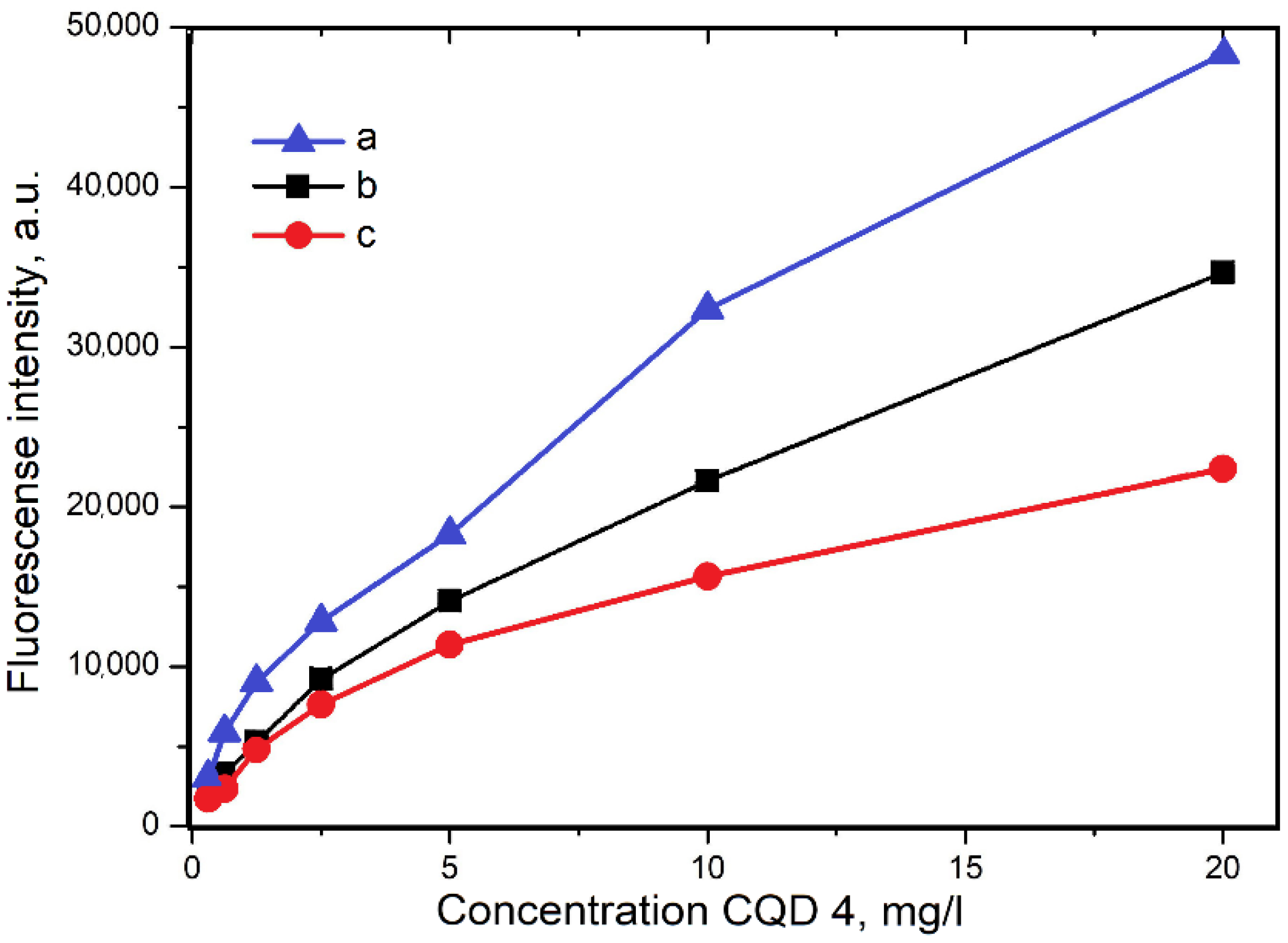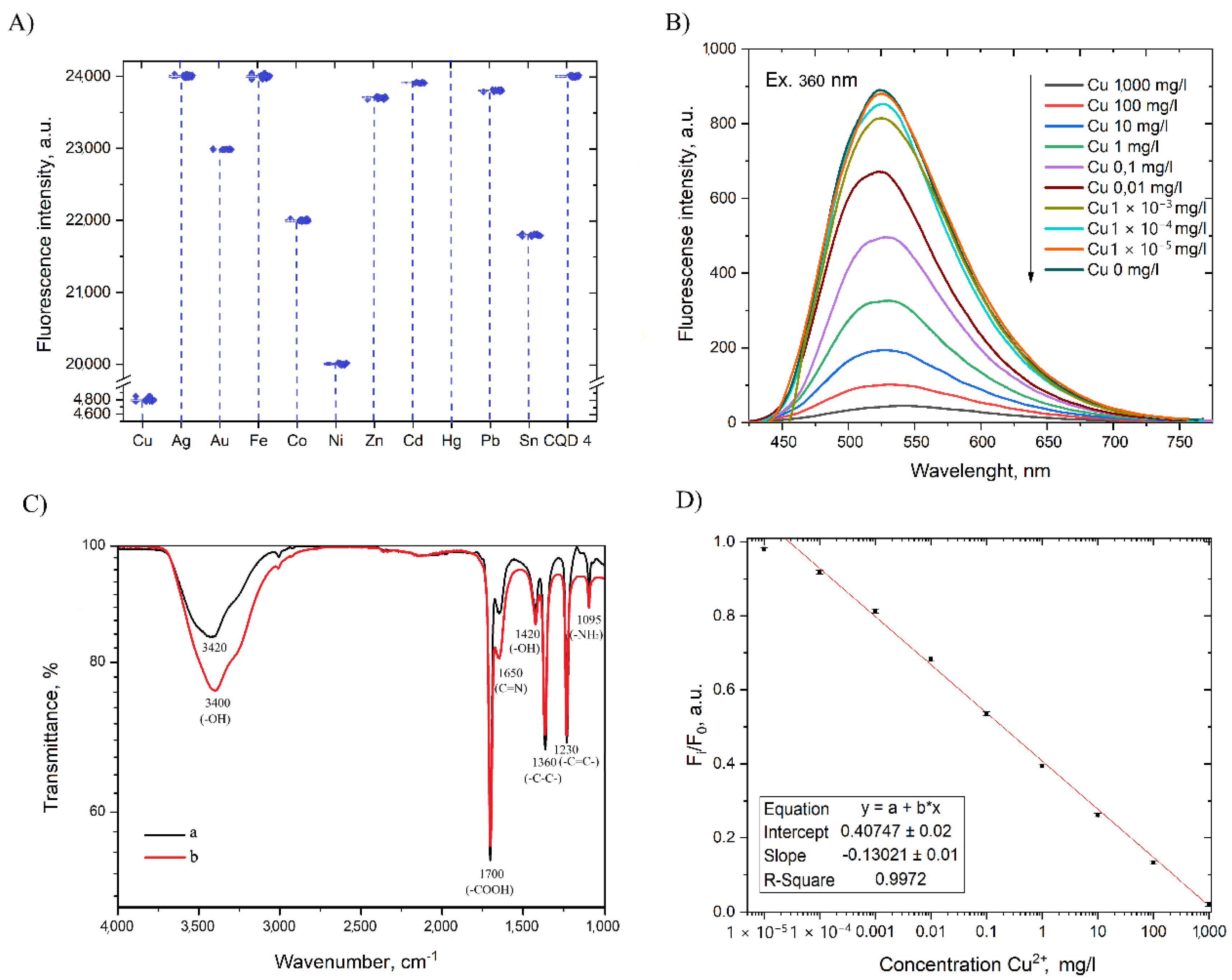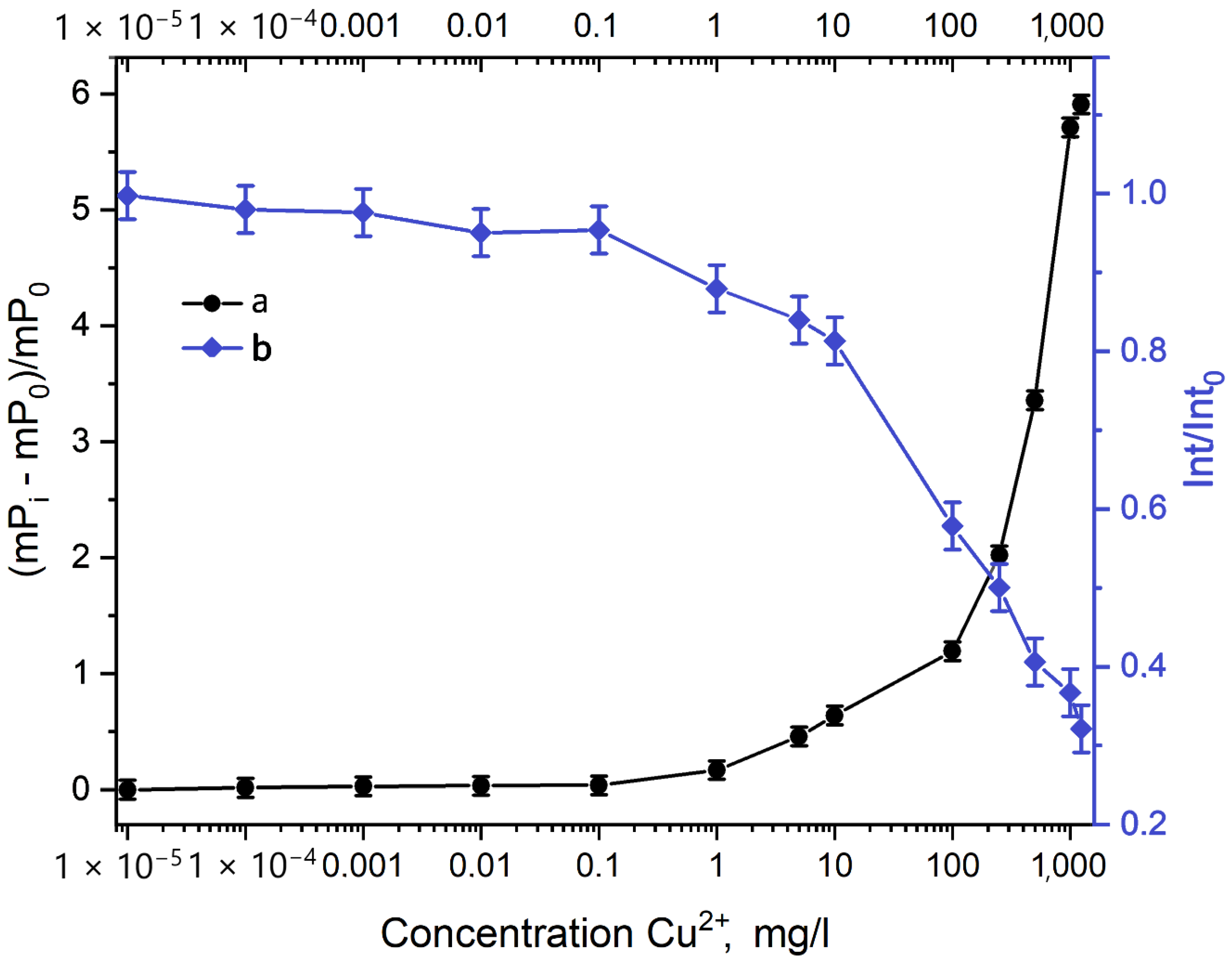Water-Soluble Carbon Quantum Dots Modified by Amino Groups for Polarization Fluorescence Detection of Copper (II) Ion in Aqueous Media
Abstract
:1. Introduction
2. Materials and Methods
2.1. Reagents and Materials
2.2. Instruments
2.3. Synthesis of CQDs
2.4. Detection of Metal Ions
3. Results and Discussion
3.1. Characterization of CQD
3.2. Fluorescence Properties of CQD
Size Distribution of CQD 1, 3 and 4
3.3. FI Quench of CQD by Addition of Metal Ions
4. Conclusions
Author Contributions
Funding
Conflicts of Interest
References
- Mohankumar, K.; Hariharan, V.; Rao, N.P. Heavy Metal Contamination in Groundwater around Industrial Estate vs Residential Areas in Coimbatore, India. J. Clin. Diagn. Res. 2016, 10, BC05–BC07. [Google Scholar] [CrossRef] [PubMed]
- Yang, J.-Y.; Zhang, Y.; Wang, H.; Xu, Z.-L.; Eremin, S.A.; Shen, Y.-D.; Wu, Q.; Lei, H.; Sun, Y.-M. Development of fluorescence polarisation immunoassay for carbofuran in food and environmental water samples. Food Agric. Immunol. 2014, 26, 340–355. [Google Scholar] [CrossRef]
- Zhang, H.; Yang, S.; De Ruyck, K.; Beloglazova, N.V.; Eremin, S.A.; De Saeger, S.; Zhang, S.; Shen, J.; Wang, Z. Fluorescence polarization assays for chemical contaminants in food and environmental analyses. Trac Trends Anal. Chem. 2019, 114, 293–313. [Google Scholar] [CrossRef]
- McGillicuddy, N.; Nesterenko, E.P.; Nesterenko, P.N.; Jones, P.; Paull, B. Chelation ion chromatography of alkaline earth and transition metals a using monolithic silica column with bonded N-hydroxyethyliminodiacetic acid functional groups. J. Chromatogr. A 2013, 1276, 102–111. [Google Scholar] [CrossRef]
- Lopes, F.S.; Junior, O.A.; Gutz, I.G.R. Fully electrochemical hyphenated flow system for preconcentration, cleanup, stripping, capillary electrophoresis with stacking and contactless conductivity detection of trace heavy metals. Electrochem. Commun. 2010, 12, 1387–1390. [Google Scholar] [CrossRef]
- Wen, X.; Yang, Q.; Yan, Z.; Deng, Q. Determination of cadmium and copper in water and food samples by dispersive liquid–liquid microextraction combined with UV–vis spectrophotometry. Microchem. J. 2011, 97, 249–254. [Google Scholar] [CrossRef]
- Ghanemi, K.; Nikpour, Y.; Omidvar, O.; Maryamabadi, A. Sulfur-nanoparticle-based method for separation and preconcentration of some heavy metals in marine samples prior to flame atomic absorption spectrometry determination. Talanta 2011, 85, 763–769. [Google Scholar] [CrossRef]
- Li, W.; Simmons, P.; Shrader, D.; Herrman, T.J.; Uzuner, U. Microwave plasma-atomic emission spectroscopy as a tool for the determination of copper, iron, manganese and zinc in animal feed and fertilizer. Talanta 2013, 112, 43–48. [Google Scholar] [CrossRef]
- Dai, B.; Cao, M.; Fang, G.; Liu, B.; Dong, X.; Pan, M.; Wang, S. Schiff base-chitosan grafted multiwalled carbon nanotubes as a novel solid-phase extraction adsorbent for determination of heavy metal by ICP-MS. J. Hazard. Mater. 2012, 219, 103–110. [Google Scholar] [CrossRef]
- Das, P.; Ganguly, S.; Bose, M.; Mondal, S.; Das, A.; Banerjee, S.; Das, N.C. A simplistic approach to green future with eco-friendly luminescent carbon dots and their application to fluorescent nano-sensor ‘turn-off’ probe for selective sensing of copper ions. Mater. Sci. Eng. C 2017, 75, 1456–1464. [Google Scholar] [CrossRef]
- Smith, D.S.; Eremin, S.A. Fluorescence polarization immunoassays and related methods for simple, high-throughput screening of small molecules. Anal. Bioanal. Chem. 2008, 391, 1499–1507. [Google Scholar] [CrossRef] [PubMed]
- Hardman, R. A Toxicologic Review of Quantum Dots: Toxicity Depends on Physicochemical and Environmental Factors. Environ. Health Perspect. 2006, 114, 165–172. [Google Scholar] [CrossRef] [PubMed]
- Zuo, P.; Lu, X.; Sun, Z.; Guo, Y.; He, H. A review on syntheses, properties, characterization and bioanalytical applications of fluorescent carbon dots. Microchim. Acta 2015, 183, 519–542. [Google Scholar] [CrossRef]
- Simpson, A.; Pandey, R.; Chusuei, C.C.; Ghosh, K.; Patel, R.; Wanekaya, A.K. Fabrication characterization and potential applications of carbon nanoparticles in the detection of heavy metal ions in aqueous media. Carbon 2018, 127, 122–130. [Google Scholar] [CrossRef]
- Al-Douri, Y.; Badi, N.; Voon, C.H. Synthesis of carbon-based quantum dots from starch extracts: Optical investigations. Luminescence 2018, 33, 260–266. [Google Scholar] [CrossRef]
- Yuan, F.; Wang, Z.; Li, X.; Li, Y.; Tan, Z.; Fan, L.; Yang, S. Bright Multicolor Bandgap Fluorescent Carbon Quantum Dots for Electroluminescent Light-Emitting Diodes. Adv. Mater. 2017, 29, 1–6. [Google Scholar] [CrossRef]
- Fan, Y.Z.; Zhang, Y.; Li, N.; Liu, S.G.; Liu, T.; Li, N.B.; Luo, H.Q. A facile synthesis of water-soluble carbon dots as a label-free fluorescent probe for rapid, selective and sensitive detection of picric acid. Sens. Actuators B Chem. 2017, 240, 949–955. [Google Scholar] [CrossRef]
- Moreira, V.A.; Suarez, W.T.; Franco, M.D.O.K.; Neto, F.F.G. Eco-friendly synthesis of cuprizone-functionalized luminescent carbon dots and application as a sensor for the determination of copper(ii) in wastewater. Anal. Methods 2018, 10, 4570–4578. [Google Scholar] [CrossRef]
- Xu, Y.; Tang, C.-J.; Huang, H.; Sun, C.-Q.; Zhang, Y.-K.; Ye, Q.-F.; Wang, A.-J. Green Synthesis of Fluorescent Carbon Quantum Dots for Detection of Hg2+. Chin. J. Anal. Chem. 2014, 42, 1252–1258. [Google Scholar] [CrossRef]
- Ma, X.; Dong, Y.; Sun, H.; Chen, N. Highly fluorescent carbon dots from peanut shells as potential probes for copper ion: The optimization and analysis of the synthetic process. Mater. Today Chem. 2017, 5, 1–10. [Google Scholar] [CrossRef]
- LeCroy, G.E.; Yang, S.-T.; Yang, F.; Liu, Y.; Fernando, K.A.S.; Bunker, C.E.; Hu, Y.; Luo, P.G.; Sun, Y.-P. Functionalized carbon nanoparticles: Syntheses and applications in optical bioimaging and energy conversion. Co-Ord. Chem. Rev. 2016, 320–321, 66–81. [Google Scholar] [CrossRef]
- Dai, Y.; Liu, Z.; Bai, Y.; Chen, Z.; Qin, J.; Feng, F. A novel highly fluorescent S, N, O co-doped carbon dots for biosensing and bioimaging of copper ions in live cells. Rsc Adv. 2018, 8, 42246–42252. [Google Scholar] [CrossRef] [Green Version]
- Fernando, K.A.S.; Sahu, S.; Liu, Y.; Lewis, W.K.; Guliants, E.A.; Jafariyan, A.; Wang, P.; Bunker, C.E.; Sun, Y.-P. Carbon Quantum Dots and Applications in Photocatalytic Energy Conversion. Acs Appl. Mater. Interfaces 2015, 7, 8363–8376. [Google Scholar] [CrossRef] [PubMed]
- He, G.; Shu, M.; Yang, Z.; Ma, Y.; Huang, D.; Xu, S.; Wang, Y.; Hu, N.; Yang, Z.; Xu, L. Microwave formation and photoluminescence mechanisms of multi-states nitrogen doped carbon dots. Appl. Surf. Sci. 2017, 422, 257–265. [Google Scholar] [CrossRef]
- Farshbaf, M.; Davaran, S.; Rahimi, F.; Annabi, N.; Salehi, R.; Akbarzadeh, A. Carbon quantum dots: Recent progresses on synthesis, surface modification and applications. Artif. Cells Nanomed. Biotechnol. 2018, 46, 1331–1348. [Google Scholar] [CrossRef] [PubMed]
- Boonmee, C.; Noipa, T.; Tuntulani, T.; Ngeontae, W.; Boonme, C. Cysteamine capped CdS quantum dots as a fluorescence sensor for the determination of copper ion exploiting fluorescence enhancement and long-wave spectral shifts. Spectrochim. Acta Part A Mol. Biomol. Spectrosc. 2016, 169, 161–168. [Google Scholar] [CrossRef]
- Zhu, X.; Jin, H.; Gao, C.; Gui, R.; Wang, Z. Ratiometric, visual, dual-signal fluorescent sensing and imaging of pH/copper ions in real samples based on carbon dots-fluorescein isothiocyanate composites. Talanta 2017, 162, 65–71. [Google Scholar] [CrossRef]
- Zhao, L.; Li, H.; Xu, Y.; Liu, H.; Zhou, T.; Huang, N.; Li, Y.; Ding, L. Selective detection of copper ion in complex real samples based on nitrogen-doped carbon quantum dots. Anal. Bioanal. Chem. 2018, 410, 4301–4309. [Google Scholar] [CrossRef]
- Li, J.; Li, P.; Bian, M.; Huoa, D.; Hou, C.; Qin, H.; Zhang, S.-Y.; Zhang, L. A Fluorescent detection method for copper ions based on a direct redox route and desk study of wax-printed paper-based probes. Anal. Methods 2018, 10, 1895–1901. [Google Scholar] [CrossRef]
- Zhang, W.J.; Liu, S.G.; Han, L.; Luo, H.Q.; Li, N.B. A ratiometric fluorescent and colorimetric dual-signal sensing platform based on N-doped carbon dots for selective and sensitive detection of copper(II) and pyrophosphate ion. Sens. Actuators B Chem. 2019, 283, 215–221. [Google Scholar] [CrossRef]
- Li, H.; Bai, H.; Lv, Q.; Wang, W.; Wang, Z.; Wei, H.; Zhang, Q. A new colorimetric sensor for visible detection of Cu(II) based on photoreductive ability of quantum dots. Anal. Chim. Acta 2018, 1021, 140–146. [Google Scholar] [CrossRef] [PubMed]
- Wang, Y.; Wu, W.; Wu, M.; Sun, H.-D.; Xie, H.; Hu, C.; Wu, X.-Y.; Qiu, J. Yellow-visual fluorescent carbon quantum dots from petroleum coke for the efficient detection of Cu2+ ions. New Carbon Mater. 2015, 30, 550–559. [Google Scholar] [CrossRef]
- Chowdhury, S.; Rooj, B.; Dutta, A.; Mandal, U. Review on Recent Advances in Metal Ions Sensing Using Different Fluorescent Probes. J. Fluoresc. 2018, 28, 999–1021. [Google Scholar] [CrossRef] [PubMed]
- Dager, A.; Uchida, T.; Maekawa, T.; Tachibana, M. Synthesis and characterization of Mono-disperse Carbon Quantum Dots from Fennel Seeds: Photoluminescence analysis using Machine Learning. Sci. Rep. 2019, 9, 1–12. [Google Scholar] [CrossRef]
- Kumar, P.; Bhatt, G.; Kaur, R.; Dua, S.; Kapoor, A. Synthesis and modulation of the optical properties of carbon quantum dots using microwave radiation. Full Nanotub. Carbon Nanostructures 2020, 28, 724–731. [Google Scholar] [CrossRef]
- Dots, Q. Facile Synthesis of Surface-Modified Carbon. Materials 2020, 13, 3313. [Google Scholar]
- Rooj, B.; Dutta, A.; Islam, S.; Mandal, U. Green Synthesized Carbon Quantum Dots from Polianthes tuberose L. Petals for Copper (II) and Iron (II) Detection. J. Fluoresc. 2018, 28, 1261–1267. [Google Scholar] [CrossRef]
- Smith, A.M.; Nie, S. Semiconductor Nanocrystals: Structure, Properties, and Band Gap Engineering. Acc. Chem. Res. 2010, 43, 190–200. [Google Scholar] [CrossRef] [Green Version]
- Mai, X.-D.; Chi, T.T.K.; Nguyen, T.-C.; Ta, V.-T. Scalable synthesis of highly photoluminescence carbon quantum dots. Mater. Lett. 2020, 268, 127595. [Google Scholar] [CrossRef]
- Liu, X.; Gao, W.; Zhou, X.; Ma, Y. Pristine graphene quantum dots for detection of copper ions. J. Mater. Res. 2014, 29, 1401–1407. [Google Scholar] [CrossRef]
- Jiang, S.; Lu, Z.; Su, T.; Feng, Y.; Zhou, C.; Hong, P.; Sun, S.; Li, C.; Lu; Su; et al. High Sensitivity Detection of Copper Ions in Oysters Based on the Fluorescence Property of Cadmium Selenide Quantum Dots. Chemosens 2019, 7, 47. [Google Scholar] [CrossRef] [Green Version]
- Wang, F.; Gu, Z.; Lei, W.; Wang, W.; Xia, X.; Hao, Q. Graphene quantum dots as a fluorescent sensing platform for highly efficient detection of copper(II) ions. Sens. Actuators B Chem. 2014, 190, 516–522. [Google Scholar] [CrossRef]
- Rong, M.-C.; Zhang, K.-X.; Wang, Y.; Chen, X. The synthesis of B, N-carbon dots by a combustion method and the application of fluorescence detection for Cu2+. Chin. Chem. Lett. 2017, 28, 1119–1124. [Google Scholar] [CrossRef]
- Han, T.; Yuan, Y.; Kang, H.; Zhang, Y.; Dong, L. Ultrafast, sensitive and visual sensing of copper ions by a dual-fluorescent film based on quantum dots. J. Mater. Chem. C 2019, 7, 14904–14912. [Google Scholar] [CrossRef]







| S.No. | Sample Code | Citric Acid, mol | Ascorbic Acid, mol | Ammonium Dihydrogen Phosphate, mol | 1st Step Microvalve Irradiation, s | Trilon-B (EDTA-Na2), mol | 2nd Step Microvalve Irradiation, s |
|---|---|---|---|---|---|---|---|
| 1. | CQD 1 | 0.044 | - | 0.022 | 60 | - | - |
| 2. | CQD 2 | - | 0.044 | 0.022 | 60 | - | - |
| 3. | CQD 3_1 | 0.044 | - | 0.022 | 60 | 0.004 | - |
| 4. | CQD 3_2 | 0.044 | - | 0.022 | 60 | 0.005 | - |
| 5. | CQD 3_3 | 0.044 | - | 0.022 | 60 | 0.006 | - |
| 6. | CQD 3_4 | 0.044 | - | 0.022 | 60 | 0.007 | - |
| 7. | CQD 3_5 | 0.044 | - | 0.022 | 60 | 0.008 | - |
| 8. | CQD 4_1 | 0.044 | - | 0.022 | 60 | 0.004 | 30 |
| 9. | CQD 4_2 | 0.044 | - | 0.022 | 60 | 0.005 | 30 |
| 10. | CQD 4_3 | 0.044 | - | 0.022 | 60 | 0.006 | 30 |
| 11. | CQD 4_4 | 0.044 | - | 0.022 | 60 | 0.007 | 30 |
| 12. | CQD 4_5 | 0.044 | - | 0.022 | 60 | 0.008 | 30 |
Publisher’s Note: MDPI stays neutral with regard to jurisdictional claims in published maps and institutional affiliations. |
© 2020 by the authors. Licensee MDPI, Basel, Switzerland. This article is an open access article distributed under the terms and conditions of the Creative Commons Attribution (CC BY) license (http://creativecommons.org/licenses/by/4.0/).
Share and Cite
Yakusheva, A.; Muratov, D.S.; Arkhipov, D.; Karunakaran, G.; Eremin, S.A.; Kuznetsov, D. Water-Soluble Carbon Quantum Dots Modified by Amino Groups for Polarization Fluorescence Detection of Copper (II) Ion in Aqueous Media. Processes 2020, 8, 1573. https://doi.org/10.3390/pr8121573
Yakusheva A, Muratov DS, Arkhipov D, Karunakaran G, Eremin SA, Kuznetsov D. Water-Soluble Carbon Quantum Dots Modified by Amino Groups for Polarization Fluorescence Detection of Copper (II) Ion in Aqueous Media. Processes. 2020; 8(12):1573. https://doi.org/10.3390/pr8121573
Chicago/Turabian StyleYakusheva, Anastasia, Dmitry S. Muratov, Dmitry Arkhipov, Gopalu Karunakaran, Sergei A. Eremin, and Denis Kuznetsov. 2020. "Water-Soluble Carbon Quantum Dots Modified by Amino Groups for Polarization Fluorescence Detection of Copper (II) Ion in Aqueous Media" Processes 8, no. 12: 1573. https://doi.org/10.3390/pr8121573






